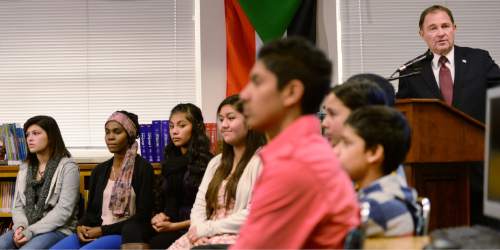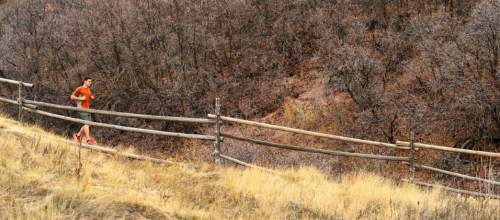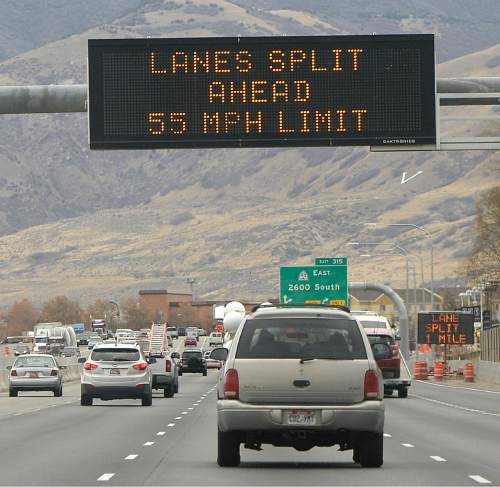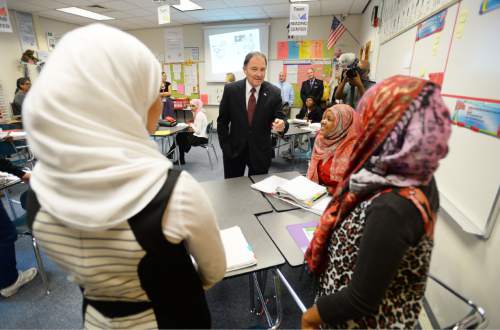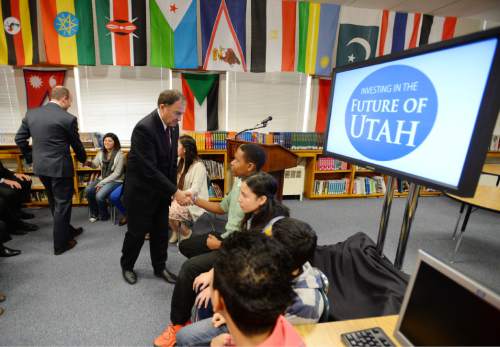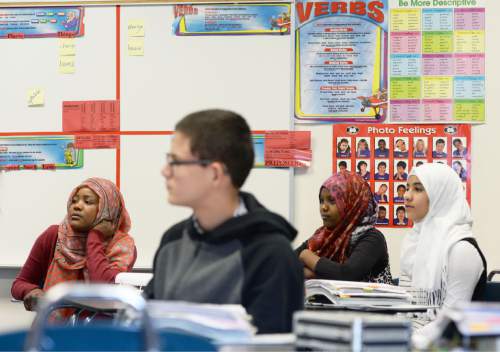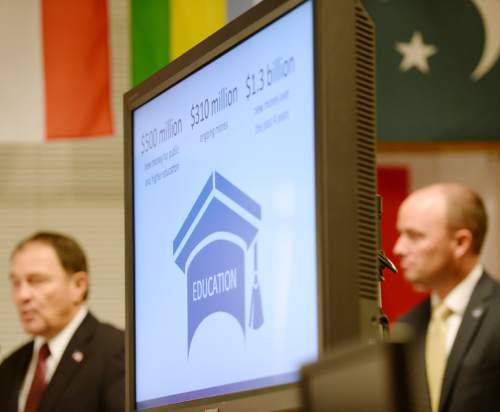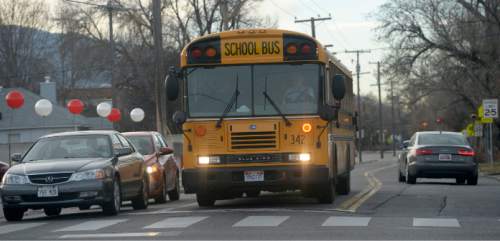This is an archived article that was published on sltrib.com in 2014, and information in the article may be outdated. It is provided only for personal research purposes and may not be reprinted.
Gov. Gary Herbert is proposing the biggest increase in per-pupil spending in 25 years, body cameras for all Utah Highway Patrol troopers and funding for his contentious Healthy Utah plan to help the poor buy medical insurance.
He also may be reigniting a fight with legislators over tens of millions of dollars pegged for road construction and opening the door to the first gas-tax increase in 17 years.
"This is a darn good budget," Herbert told The Salt Lake Tribune on Thursday afternoon. "In today's Utah, where we need money to be put in education, still continue to build transportation, help those most vulnerable among us with Healthy Utah … this is a great budget going forward, responding to what we need today and looking forward."
Republican legislative leaders criticized Herbert's attempt to be a fiscal Santa Claus, saying the governor was building unrealistic expectations and that Utahns might be disappointed down the road. They warned the big increases might not be sustainable, the costs of other projects were understated and funding for some programs could dry up.
The proposals are highlights from Herbert's $14.3 billion spending plan, unveiled Thursday morning at Granite Park Junior High, an annual ritual that marks the governor's opening bid in the budget process that ultimately will have to be negotiated with an oftentimes-skeptical Legislature.
The governor's spending plan comes after news that state leaders will have an additional $638 million to pay for an array of programs. The bulk of the surplus comes from higher income-tax collections and, under the Utah Constitution, must go toward education.
Herbert proposes $161 million in new per-pupil spending, a 6.25 percent jump, snapping the trend of minor bumps and — in the depths of the economic downturn — dips in the amount the state spends on each of its more than 620,000 students.
The Republican governor emphasizes that the money will flow to school districts, where he believes local officials can spend it most effectively to address specific needs. But it is likely to translate into a sizable pay raise for Utah teachers, as well.
"We believe in local control," Herbert said. "We also expect the local superintendents and school boards, the local principals, to manage the resources as they see fit as they have unique needs in the local community. The demographics in Utah are not the same, and we would not expect a one-size-fits-all solution to education."
The increased per-pupil spending comes on top of $58 million in his budget to cover nearly 8,000 new students expected to enroll in Utah's public and charter schools next year — the lowest level of growth in a decade.
He also seeks $56 million to build and renovate schools and to upgrade the technology infrastructure.
David Crandall, chairman of the state school board, said he was happy to see the governor recognize the importance of public education. The board had asked for funding for items such as teacher training, but said the per-pupil-spending spike along with flexibility for districts lets local officials address those needs.
"It's a pretty sizable increase," he said, although he expects legislators will want assurances on how the money is spent. "I think that's really going to be one of the sticking points. … With that amount of additional money going to education, what kind of accountability are we going to have for how it is used?"
Sharon Gallagher-Fishbaugh, president of the Utah Education Association, the state's largest teachers group, said the governor's proposed education boost is a "worthwhile investment."
"It also goes a long way toward restoring funding to pre-recession levels," she said, "and positions us to begin addressing the additional resources so desperately needed in Utah's grossly underfunded public school classrooms."
A proposal that may run into resistance in the GOP-controlled Legislature is Herbert's plan to siphon $94 million from construction and repair of Utah roads to other needs.
In 2011, the Legislature passed a bill earmarking a portion of the sales tax for road projects. The governor vetoed the bill, believing the road dollars should compete against other state needs each year. Lawmakers overrode the veto and the law took effect.
Herbert said the state has long-term road needs — an estimated $7 billion in unfunded demands during the next 30 years — and that there has to be a discussion about whether to raise the gas tax or sales tax to pay for them. But the needs in education and other areas are immediate.
"All the things we've talked about for education," he said, "I need today."
Herbert told The Tribune he sees the logic in adjusting the gas tax to catch up with inflation — it has not been raised in 17 years — and that would require an increase of at least 10 cents per gallon.
"If ever there was a time to put a tax [increase] on gasoline, it's now," said Herbert, who hopes to reach some consensus with lawmakers during the upcoming legislative session, which begins Jan. 26.
Utah Department of Transportation Executive Director Carlos Braceras said that the $94 million loss would not delay any of the current road projects.
The road set-aside is just one of more than two dozen earmarks that now put $568 million of the state budget off-limits. The governor would like to see that change and believes the money would be better spent in other areas.
House Speaker-elect Greg Hughes, R-Draper, said the governor may be making promises in education and elsewhere the state cannot keep and building unrealistic expectations with his lofty budget numbers.
"The area of discussion in the coming months is the fear of over-promising and under-delivering," Hughes said. "Our ability to keep those commitments [to education and state agencies] is as important as the commitments we make."
Senate President Wayne Niederhauser, R-Sandy, said the state faces billions in unfunded transportation needs and if the governor wants to take money out of the earmark, he needs to identify a way to replace it. Legislators have been discussing the possibility of the gas tax and will continue to debate it during the session.
Herbert is requesting $10.5 million for a series of prison reforms, aimed at helping prevent released inmates from ending up back behind bars. Sixty-three percent of parolees return to prison within three years and that statistic needs to change, Herbert said.
He requests $1 million to start buying body cameras for UHP troopers. The governor said that, after the police shootings in Ferguson, Mo., and elsewhere, it makes sense for interactions between law enforcement and the public to be recorded. It will likely take a few years to equip all of the state's troopers with the cameras.
Herbert also is budgeting $46 million for the prison-relocation project, although it is unclear exactly how that money will be used. A commission is studying the best place to build a new prison, so it remains to be seen if the funds will be used to hire consultants, acquire land or begin plans for the new facility.
"Something has to happen," said the governor's budget boss, Kristin Cox. "Those facilities down in Draper can't remain where they are."
Utah's colleges and universities also would fare well under Herbert's plan, with a 3 percent pay hike for higher-education employees, $15 million in incentives for schools that lift the number of graduates and meet other performance objectives, and $13 million to the Utah College of Applied Technology to train students for high-tech jobs.
"Since [Utah higher-education] institutions compete in a national talent marketplace, we are pleased that the governor put higher-ed compensation as a top priority," said Utah Commissioner of Higher Education Dave Buhler.
Herbert recommends allocating $4.6 million to administer his proposed Healthy Utah program, his version of Medicaid expansion that would cover 95,000 of the poorest uninsured Utahns. The bulk of the program would be funded through federal dollars, but legislative leaders have resisted Herbert's plan, fearful that it would put the state on the hook when the federal money disappears.
Both Niederhauser and Hughes said the governor is ignoring the long-term costs of expanding Medicaid. While federal dollars would cover the program in its first year, Washington's support gets scaled back starting in 2020. Niederhauser said that one study projected the Healthy Utah program would end up costing the state $93 million a year. If that's the case, legislators should start finding a way to pay for it.
The governor also has three initiatives aimed at improving air quality. He wants $20 million to replace old school buses; $1.5 million to provide incentives to homes and small businesses to replace old equipment with newer, cleaner machinery; and $750,000 for air-quality research.
Legislative leaders are miles apart from the governor on the fundamental question of how much to spend. In addition to the dispute about the $94 million in road funding, legislators already have decided to sock away $116 million. They believe the rapid economic growth may be creating a bubble, and they don't want to overextend the state in case that bubble bursts.
Moreover, when lawmakers gather in January, they will be looking for ways to cut 2 percent across state government.
Cox said cutting when the economy is robust sends the wrong message to agencies and, while having money in reserve is wise, the state already has more stashed in its Rainy Day Funds than it did before the Great Recession.
Tribune reporters Annie Knox and Benjamin Wood contributed to this story.
Twitter: @RobertGehrke


